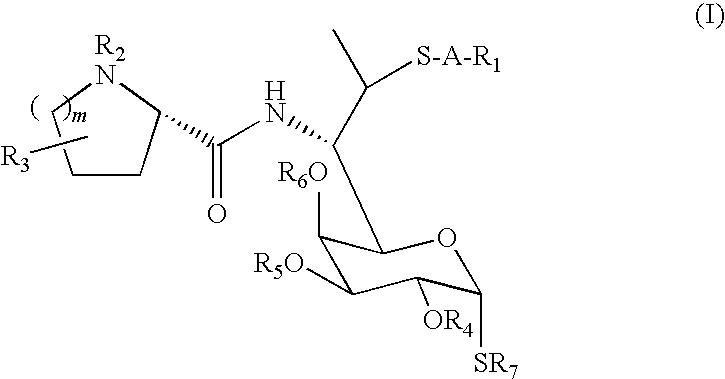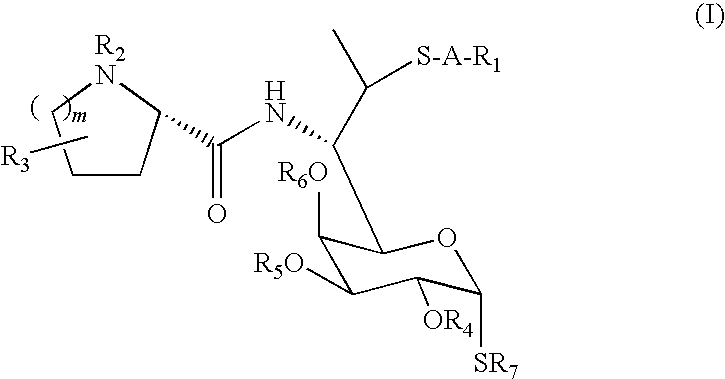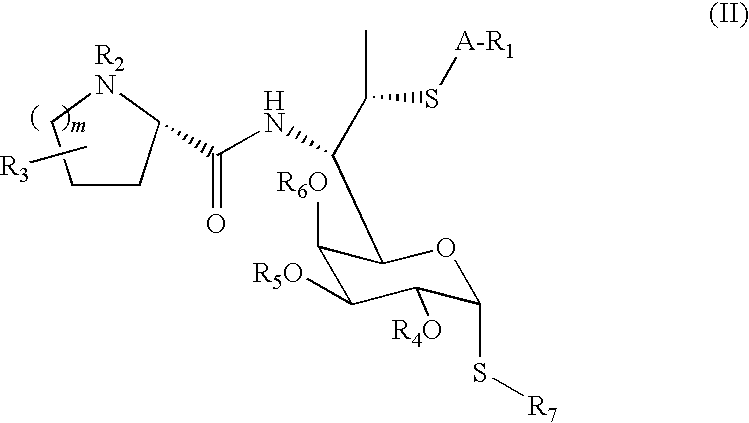Lincosamide derivatives and antimicrobial agents comprising the same as active ingredient
- Summary
- Abstract
- Description
- Claims
- Application Information
AI Technical Summary
Benefits of technology
Problems solved by technology
Method used
Image
Examples
reference example 1
5-(4-Bromophenyl)pyrimidine
[0294]5-Bromopyrimidine (954 mg, 6 mmol) and 1.0 g (5.0 mmol) of 4-bromophenylboronic acid were dissolved in 20 ml of N,N-dimethylformamide and 5 ml of water. Tetrakistriphenylphosphine palladium (590 mg, 0.5 mmol) and 830 mg (7.5 mmol) of sodium carbonate were added to the solution, and the mixture was stirred at 80° C. for 2.5 hr. Ethyl acetate (60 ml) and 8.5 ml of water were added to the reaction solution. The mixture was filtered through Celite. The filtrate as an organic layer was washed five times with 30 ml of water. The organic layer was dried over anhydrous sodium sulfate and was filtered. The solvent was then removed by distillation, and the residue was purified by column chromatography on silica gel (n-hexane:ethyl acetate=5:1) to give 960 mg (yield 82%) of the title compound.
[0295]1H-NMR (300 MHz, CDCl3) δ: 7.52 (2H, d, J=7.5 Hz), 7.56 (2H, d, J=7.5 Hz), 9.00 (2H, s), 9.22 (1H, ddd, J=s).
[0296]MS (FAB) m / z: 234 (M++1).
[0297]The following compo...
reference example 2
5-(4-Bromophenyl)-1-methyl)-1,2,3,6-tetrahydropyridine
[0299]Iodomethane (0.5 ml, 8.0 mmol) was added to a solution of 199 mg (0.85 mmol) of 3-(4-bromophenyl)pyridine in acetonitrile (11 ml), and the mixture was heated under reflux with stirring for 14 hr. The solvent was removed by distillation. The residue was dissolved in 2.7 ml of methanol and 2.7 ml of water. Sodium borohydride (292 mg) was added to the solution under ice cooling, and the mixture was stirred under ice cooling for one hr and at room temperature for 20 hr. The reaction solution was adjusted to pH 1 by the addition of 5 N hydrochloric acid and was then concentrated. The residue was adjusted to pH 9 by the addition of aqueous ammonia. The aqueous solution was extracted thrice with 10 ml of ethyl acetate. The organic layers were combined and were dried over anhydrous sodium sulfate followed by fitration. The filtrate was concentrated under the reduced pressure, and the residue was purified by column chromatography on...
reference example 3
Step (ii) of Reference Example 3
3-((4-Bromophenyl)(methoxymethyl)methyl)pyridine
[0307]Sodium hydride (24.8 mg, 0.62 mmol) and 35 μl (0.56 mmol) of iodomethane were added to a solution of 97.9 mg (0.37 mmol) of the title compound produced in step (i) of Reference Example 3 in N,N-dimethylformamide (2 ml), and the mixture was stirred at room temperature for 2 hr. The reaction solution was diluted with 10 ml of ethyl acetate, and the diluted solution was washed with a saturated aqueous ammonium chloride solution. The aqueous layer was extracted twice with 3 ml of ethyl acetate. The organic layers were combined and were washed with 25% brine, were dried over anhydrous sodium sulfate, and were then filtered. The filtrate was concentrated under the reduced pressure, and the residue was purified by column chromatography on silica gel (n-hexane:ethyl acetate=3:1) to give 56.2 mg (yield 55%) of the title compound.
[0308]1H-NMR (300 MHz, CDCl3) δ: 3.38 (3H, s), 5.23 (1H, s), 7.22 (2H, d, J=8.7...
PUM
 Login to View More
Login to View More Abstract
Description
Claims
Application Information
 Login to View More
Login to View More - Generate Ideas
- Intellectual Property
- Life Sciences
- Materials
- Tech Scout
- Unparalleled Data Quality
- Higher Quality Content
- 60% Fewer Hallucinations
Browse by: Latest US Patents, China's latest patents, Technical Efficacy Thesaurus, Application Domain, Technology Topic, Popular Technical Reports.
© 2025 PatSnap. All rights reserved.Legal|Privacy policy|Modern Slavery Act Transparency Statement|Sitemap|About US| Contact US: help@patsnap.com



